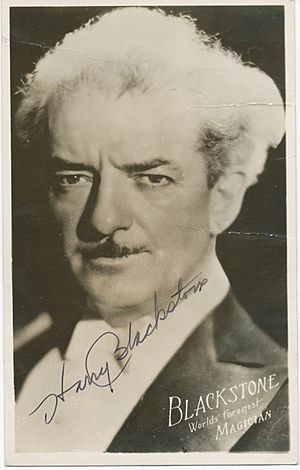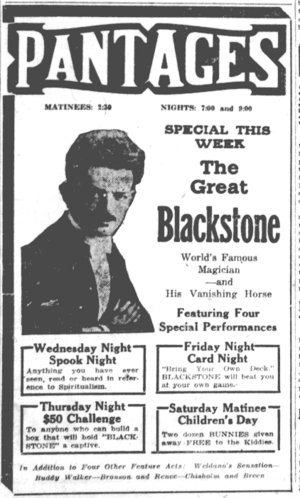Harry Blackstone Sr. facts for kids
Quick facts for kids
Harry Blackstone Sr.
|
|
|---|---|

Harry Blackstone in a 1944 advertisement
|
|
| Born |
Henry Boughton
September 27, 1885 Chicago, Illinois, U.S.
|
| Died | November 16, 1965 (aged 80) Hollywood, California, U.S.
|
| Other names | Harry Bouton Harry Bouton Blackstone |
| Occupation | Magician |
| Children | Harry Blackstone Jr. |
Harry Bouton Blackstone, born Henry Boughton (September 27, 1885 – November 16, 1965), was a very famous stage magician. He was also an illusionist in the 20th century. Harry Blackstone was born in Chicago, Illinois. He started doing magic when he was a teenager. He became very popular, especially during World War II. He entertained soldiers as a USO performer. People often called him The Great Blackstone. His son, Harry Blackstone Jr., also became a well-known magician. Harry Blackstone Sr. had help from his younger brother, Pete Bouton. Pete was the stage manager for all of his shows.
Contents
Magic Shows and Career
Blackstone was a classic, elegant magician. He was like older famous magicians such as Howard Thurston and Harry Kellar. He was one of the last magicians to perform in this style in America. He usually wore a fancy suit with a white tie and tails. He traveled with many large illusions. He also had a big team of assistants in uniforms. For many years, he toured in the Midwest. He often performed all day between movie showings.
Blackstone often stayed quiet during his big stage shows. A live orchestra played lively music of the time. Songs like "Who" and "Chinatown" were often heard.
Amazing Illusions
One of his special illusions was called "The Dream of Princess Karnac." In this trick, a woman lay on a couch. Unlike other magicians, Blackstone did not cover her. This was his version of the Kellar Levitation.
Another amazing illusion involved a cabinet. A woman would step into it. The cabinet had many bright, clear light bulbs. When Blackstone pushed the front of the cabinet, the bulbs seemed to go through the holes. The audience would hear a scream. Then, the cabinet would turn. It looked like the woman was pierced by the bright lights. Of course, she was always safe.
His "Sawing a woman in half" trick was also unique. He used a large electric circular saw. It was about three to four feet wide. The saw was in an open frame. Blackstone's version was different. The woman lay on a table. A motor pulled the table through the saw blade. Blackstone would first saw a piece of wood. This showed how real the saw was. Then, a female assistant lay on the table. Metal clamps held her middle section. The blade whirred loudly. It seemed to cut through her body. Ripping sounds were heard. The woman shrieked. Small pieces seemed to fly from the blade. When the saw stopped, she would stand up unharmed.
Gentler Magic Tricks
Blackstone also performed a gentler trick. It was called "Vanishing bird cage". He would invite many children onto the stage. They would all put their hands on a small cage. Inside the cage was a canary. Blackstone would lower the cage. Then, he seemed to toss it into the air. Both the bird and the cage would disappear. This always surprised and delighted the children.
One of his most beautiful effects was "The Enchanted Garden." In this trick, many colorful feather flowers would appear. They came from under a cloth. They also appeared on tables and stands. Soon, the stage was filled with bright colors.
"The Floating Light Bulb" was perhaps his most famous trick. The theater would become dark. Blackstone would take a lit bulb from a lamp. He would make it float, still glowing, through a small hoop. Then, he would walk off the stage. The light bulb would float out over the audience's heads. A Dutch illusionist named Hans Klok now performs this trick. He received it after Blackstone Jr. passed away.
When Blackstone was not touring, he lived on an island. He called it Blackstone Island. It was near Colon, Michigan. He also briefly owned a magic company there. His partner was an Australian magician named Percy Abbott. Their business lasted only 18 months. After they closed the company, Abbott started his own magic business. It was called Abbott's Magic Novelty Company. This company sold simple magic tricks to young boys. They also sold tricks to professional magicians worldwide. They even built large illusions.
Comic Books and Radio Shows
In 1941, a company called Street & Smith made Blackstone a comic book star. He appeared in Super-Magician Comics. His friend, magician Walter B. Gibson, wrote the stories. In the comics, Blackstone traveled the world. He performed amazing magic. He also fought against strange villains. In one issue, he saved a young woman named Rhoda from pirates. She then became his regular helper. Blackstone appeared in the comic every month. This continued until February 1946.
In 1946, E. C. Stoner created another comic series. It was called Blackstone, Master Magician. This comic only ran for three issues. Later, it was brought back for one more issue by EC Comics.
The comic stories were made into a radio show in 1948. It was called Blackstone, the Magic Detective. It was broadcast on WOR-Mutual. Ed Jerome played Harry Blackstone. Ted Osborne and Fran Carlon played his friends John and Rhoda. Each episode also taught a magic trick. Young listeners could try the trick at home. The show aired from October 1948 to April 1949.
Later Life and Passing
Blackstone spent his last years performing at The Magic Castle. This is a famous magic place in Hollywood, California. He passed away on November 16, 1965, in Hollywood. He was 80 years old. He was buried near his old home in Colon, Michigan. The main street there was even renamed Blackstone Avenue to honor him.
Legacy and Tributes
In 1985, Harry Blackstone Jr. honored his father. It was the 100th anniversary of his father's birth. He gave two special items to the Smithsonian Institution in Washington D.C. One was the original floating light bulb. Thomas Edison himself designed and built it. The other was the original Casadega Cabinet. This was used in the "Dancing Handkerchief" illusion. This was the first time the Smithsonian accepted a donation related to magic.
Harry Blackstone Sr. is remembered with two official historical markers in Michigan:
- American Museum of Magic
- Colon, Michigan / Harry Blackstone


